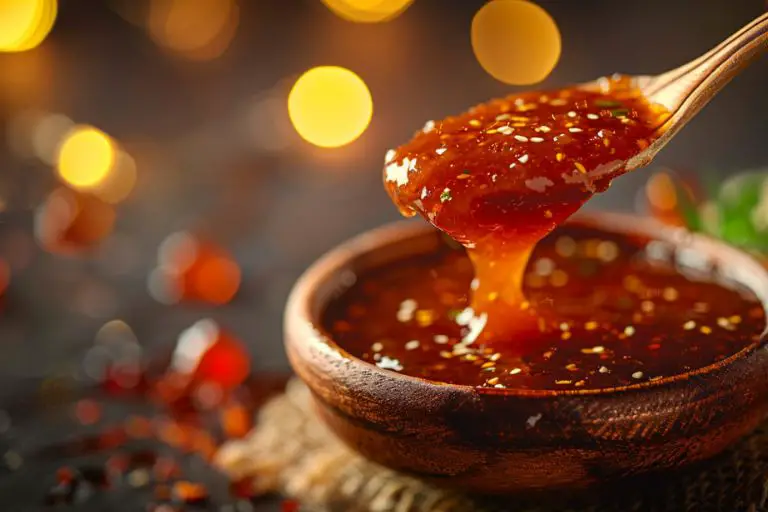Introduction
Sweet and Sour Sauce a cornerstone of Asian cuisine, is beloved worldwide for its delightful harmony of sweetness and tanginess. This versatile condiment can elevate simple dishes to extraordinary levels, making it a must-have in every culinary enthusiast’s kitchen. Our recipe offers a meticulously crafted blend of ingredients, ensuring a perfect balance that will enhance any meal.
Ingredients Needed for Sweet and Sour Sauce
To create this iconic sauce, you’ll need the following ingredients:
- 1/2 cup white sugar – Adds the essential sweetness to the sauce.
- 1/3 cup apple cider vinegar – Provides the tangy backbone, crucial for that signature sour kick.
- 1/4 cup ketchup – Contributes color and a hint of tomato flavor, enriching the sauce’s complexity.
- 1 tablespoon soy sauce – Offers a depth of umami, tying the sweet and sour elements together seamlessly.
- 1 teaspoon garlic powder – Infuses the sauce with a subtle, aromatic garlic essence.
- 1 tablespoon cornstarch – Acts as a thickener to give the sauce its characteristic silky, glossy texture.
- 1/4 cup water – Needed to dilute the cornstarch for smooth integration into the sauce.
How To Make Sweet and Sour Sauce
Step 1: Combine Base Ingredients In a small saucepan, mix together the white sugar, apple cider vinegar, ketchup, and soy sauce. This blend of ingredients forms the foundational flavor profile of the sauce. Set your stove to medium heat and stir continuously. It’s crucial to keep the mixture moving to prevent any ingredient from sticking to the bottom of the pan and burning, which could introduce a bitter flavor.
Step 2: Prepare the Cornstarch Mixture In a separate, small bowl, whisk together the cornstarch and water until the mixture is smooth and free of lumps. This slurry will act as the thickening agent for your sauce, ensuring it achieves the perfect consistency that clings lovingly to your dishes.
Step 3: Thicken the Sauce Once your base mixture starts to bubble gently, reduce the heat to low. Slowly drizzle in the cornstarch mixture while continuously stirring the contents of the saucepan. It’s important to add the cornstarch gradually while stirring to avoid any clumps from forming.
Step 4: Finalize the Sauce Continue to cook the sauce on low heat, stirring constantly as it thickens. This process should take about 1-2 minutes. Once the sauce has reached a rich, glossy consistency that coats the back of a spoon, remove the saucepan from the heat.
Step 5: Cooling and Storage Allow the sauce to cool to room temperature before transferring it to a clean, airtight container. The sweet and sour sauce can be refrigerated and remains fresh for up to a week. This makes it convenient to have on hand for quickly enhancing weeknight dinners or spontaneous meals.
Serving Suggestions
This homemade sweet and sour sauce is incredibly versatile and can be used in numerous dishes. It pairs excellently with grilled or fried meats, especially chicken and pork. Drizzle it over crispy tofu or stir-fried vegetables for a delightful vegetarian option. It also makes an excellent dipping sauce for appetizers like spring rolls and chicken tenders.
Conclusion
Crafting your own sweet and sour sauce is an easy way to add a burst of flavor to any meal. By following these steps, you’ll create a sauce that not only rivals but surpasses store-bought versions in both taste and freshness. Dive into the world of homemade sauces, and your taste buds will thank you.
FAQs
What does sweet and sour sauce taste like?
Sweet and sour sauce has a balanced flavor profile that combines sweetness and tartness. It typically features a sugary base complemented by acidic components like vinegar or citrus juice, creating a distinctively bright and tangy taste that is both refreshing and robust.
How long does homemade sweet and sour sauce last?
Homemade sweet and sour sauce can last for up to two weeks when stored properly in the refrigerator. It should be kept in an airtight container to maintain its freshness and prevent contamination.
What is traditional sweet and sour sauce made of?
Traditional sweet and sour sauce is made primarily of sugar and vinegar, which provide the foundational sweet and tart flavors. Additional ingredients may include fruit juices (like pineapple or orange), tomato paste for depth and color, and seasonings like ginger or garlic.
What if sweet and sour sauce is too sour?
If sweet and sour sauce is too sour, you can balance it by adding a sweetener, such as sugar, honey, or a syrup. Start by adding small amounts and tasting the sauce as you go, to ensure you reach the desired balance without over-sweetening.
Where does sweet and sour come from?
Sweet and sour cuisine has roots in various culinary traditions, but it is most famously associated with Chinese cuisine. The use of sugar and vinegar to create this flavor profile can also be found in other cultures, such as in Italian agrodolce dishes.
Does sweet and sour sauce contain tomato?
Some variations of sweet and sour sauce may contain tomato, which adds a rich, umami flavor and a deep red color. Tomato is not a traditional ingredient in all recipes, but it is commonly included in Western adaptations of the sauce.
What does sweet and sour mix contain?
Sweet and sour mix, typically used in cocktails, contains a blend of lemon and/or lime juice and a sweetener like sugar syrup. It’s designed to provide a consistent tart and sweet base for a variety of mixed drinks.
What is the Flavour of sweet and sour?
The flavor of sweet and sour is a combination of sweetness from sugar or syrups and tartness from vinegar or citrus juice. This mix creates a lively, appealing taste that enhances the flavor of various dishes, especially in sauces and marinades.
Why are sweet sauces used?
Sweet sauces are used in cooking to add depth and complexity to dishes, counterbalance spiciness or bitterness, and enhance the overall flavor profile. They can also help in caramelizing and adding a glossy finish to cooked foods.



